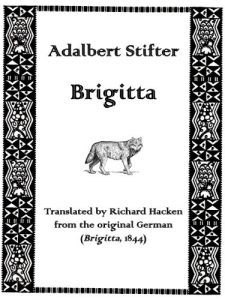- Modern English translation
- From German original of "Brigitta"
- Annotated
Adalbert Stifter (1805-1868) is today considered by many the premier Austrian prose writer of the nineteenth century. Stifter’s prose is marked less by dynamic external events than by hints at the inner life of the soul. What happens in the heart and mind of his protagonists is accompanied by descriptions of a beneficent natural order. This proceeds from what Stifter called the “gentle law” of life: the allegedly “small events” of life overshadow the grand and violent experiences. To some extent, the outer world portrayed in Stifter’s novellas – whether deep in the Austrian Alps or, in the present work, on a Hungarian country estate – seems to parallel the human psyche. Thus, idyllic and almost utopian landscapes point to the possibility of happiness, while, conversely, dangers confronting man in nature – wolves, heavy snows, barren deserts – may suggest misery and unhappiness, but any evil intent is negated by the very fact that these forces are natural and indifferent: wolves attack humans only when hunger drives them to it, snows are life-giving and beautiful as well as treacherous, and deserts are harsh and unfeeling but amenable to being irrigated. Consequently, there appears to be no calculated evil in Stifter’s world – only the opportunity to join the natural order.
The reworked 1847 version of Brigitta is the one translated here. The story moves between a number of inner (psychological) and outer (natural and societal) levels: on the outside are such things as wolves, stony wastelands, nineteenth-century family values and the benefits of agricultural cooperation. On the inside, mirrored by outer events, are the power of forgiveness and the constancy of love. The two sides are woven together in a central conflict between apparent outer beauty and true inner beauty.
The story unfolds slowly and meticulously, with many a glance sideways at cultural artifacts of the Magyar people, the wonders of viticulture and animal husbandry, and the stark beauty of the puszta [Hungarian steppe].
Despite few references to God or religion, there are clues that one of Stifter’s aims was to depict the possibilities of reconciliation or rebinding to which the word “religion” originally referred. One direct reference comes in the first paragraph – a philosophical template or spiritual guide to the story following it. There Stifter mentions an abyss where God and the spirits dwell that is at once serene (or even cheerful) and at the same time unfathomable. Thus the import of what follows is not to be analyzed in objective, scientific terms, he suggests, but is discernible to the heart or soul. Metaphorically — both with agricultural descriptions bordering on the Garden of Eden and with human relations no less utopian – he is describing a return to paradise.
- From German original of "Brigitta"
- Annotated
Adalbert Stifter (1805-1868) is today considered by many the premier Austrian prose writer of the nineteenth century. Stifter’s prose is marked less by dynamic external events than by hints at the inner life of the soul. What happens in the heart and mind of his protagonists is accompanied by descriptions of a beneficent natural order. This proceeds from what Stifter called the “gentle law” of life: the allegedly “small events” of life overshadow the grand and violent experiences. To some extent, the outer world portrayed in Stifter’s novellas – whether deep in the Austrian Alps or, in the present work, on a Hungarian country estate – seems to parallel the human psyche. Thus, idyllic and almost utopian landscapes point to the possibility of happiness, while, conversely, dangers confronting man in nature – wolves, heavy snows, barren deserts – may suggest misery and unhappiness, but any evil intent is negated by the very fact that these forces are natural and indifferent: wolves attack humans only when hunger drives them to it, snows are life-giving and beautiful as well as treacherous, and deserts are harsh and unfeeling but amenable to being irrigated. Consequently, there appears to be no calculated evil in Stifter’s world – only the opportunity to join the natural order.
The reworked 1847 version of Brigitta is the one translated here. The story moves between a number of inner (psychological) and outer (natural and societal) levels: on the outside are such things as wolves, stony wastelands, nineteenth-century family values and the benefits of agricultural cooperation. On the inside, mirrored by outer events, are the power of forgiveness and the constancy of love. The two sides are woven together in a central conflict between apparent outer beauty and true inner beauty.
The story unfolds slowly and meticulously, with many a glance sideways at cultural artifacts of the Magyar people, the wonders of viticulture and animal husbandry, and the stark beauty of the puszta [Hungarian steppe].
Despite few references to God or religion, there are clues that one of Stifter’s aims was to depict the possibilities of reconciliation or rebinding to which the word “religion” originally referred. One direct reference comes in the first paragraph – a philosophical template or spiritual guide to the story following it. There Stifter mentions an abyss where God and the spirits dwell that is at once serene (or even cheerful) and at the same time unfathomable. Thus the import of what follows is not to be analyzed in objective, scientific terms, he suggests, but is discernible to the heart or soul. Metaphorically — both with agricultural descriptions bordering on the Garden of Eden and with human relations no less utopian – he is describing a return to paradise.






